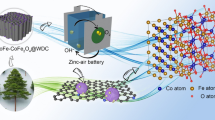Abstract
It is demonstrated that a high-temperature electrochemical reactor on the basis of zirconium dioxide (0.9ZrO2 · 0.1Y2O3) with platinum electrodes may be promising as a device for preparing samples of organic gases for isotopic assay of carbon. Owing to a high catalytic activity of the surface of a porous platinum coating, it is possible to realize full oxidation of organic gases to stoichiometric oxides at 900–950°C and an oxygen flux equivalent to an electric current of 100 µA and higher. The reproducibility of the results of isotopic assay is better than that yielded by a standard oxidation reactor. Use of the solid-electrolyte reactor in a new device as a sensor makes it possible to simultaneously measure the concentration of organic gases passing through the reactor on the basis of the charge transported by oxygen ions through the wall of a ceramic tube. Simultaneously one can monitor purity of the carrier gas.
Similar content being viewed by others
References
Perfil’ev, V.M., Demin, A.K., Kuzin, B.L., and Lipilin, A.S., Vysokotemperaturnyi elektroliz gazov (The High-Temperature Electrolysis of Gases), Moscow: Nauka, 1988.
Talanchuk, P.M., Shmatko, B.A., Zaika, L.S., and Tsvetkova, O.E., Poluprovodnikovye i tverdoelektrolitnye sensory (Sensors Based on Semiconductors and Solid Electrolytes), Kiev: Tekhnika, 1992.
Vecher, A.A. and Vecher, D.V., Tverdye elektrolity (The Solid Electrolytes), Minsk: Universitetskoe Izd., 1998.
Zuev, B.K. and Olenin, A.Yu., Zh. Anal. Khim., 2006, vol. 61, p. 157.
Sundmacher, K., Rihko-Struckmann, L.K., and Galvita, V., Catal. Today, 2005, p. 185.
Maskell, W.C., Solid State Ionics, 2000, vol. 134, p. 43.
Schmidt-Zhang, P. and Guth, U., Sen. Actuators, B, 2004, vol. 99, p. 258.
Somov, S.I., Reinhardt, G., Guth, U., and Gopel, W., Solid State Ionics, 2000, vol. 136–137, p. 543.
Shkerin, S.N. and Perfil’ev, M.V., Elektrokhimiya, 1990, vol. 26, p. 1461.
Tokarev, M.I., Fainberg, V.S., and Khodeev, Yu.S., Mass Spektrom., 2004, vol. 1, p. 179.
Handbook of Stable Isotope Analytical Techniques, Groot, P.A., Ed., Amsterdam: Elsevier, 2004, vol. 1.
Author information
Authors and Affiliations
Corresponding author
Additional information
Original Russian Text © V.S. Sevast’yanov, E.M. Galimov, N.E. Babulevich, A.A. Arzhannikov, 2007, published in Elektrokhimiya, 2007, Vol. 43, No. 4, pp. 472–478.
Rights and permissions
About this article
Cite this article
Sevast’yanov, V.S., Galimov, E.M., Babulevich, N.E. et al. Zirconium dioxide-based solid electrolyte as a means of oxidation of organic compounds during isotopic assay of carbon. Russ J Electrochem 43, 448–453 (2007). https://doi.org/10.1134/S102319350704012X
Received:
Issue Date:
DOI: https://doi.org/10.1134/S102319350704012X




